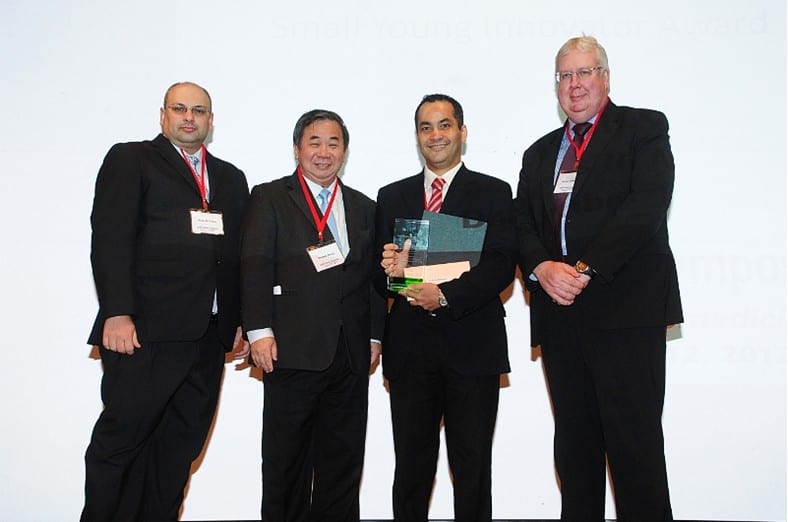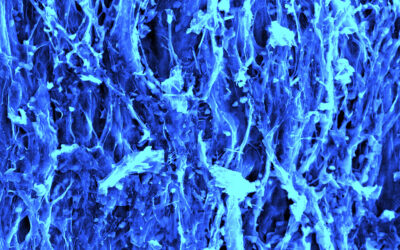The “Small Young Innovator Awards” were presented to Professor Ali Khademhosseini and Professor Hua Zhang during the recent “Small Science Symposium: Frontiers in Nanomedicine” held in Singapore from 10 – 12 December 2012. Both of them presented their prize lectures to 300 delegates during the symposium.

One of the prize winners, Professor Khademhosseini (centre right) with journal editors Dr. Jose Oliveira (far left) and Dr. Peter Gregory (far right) and Freddy Boey, provost of NTU.
Professor Khademhosseini, from Harvard-MIT Division of Health Sciences and Technology, Brigham and Women’s Hospital and Harvard Medical School, USA, received the award for his work on merging micro/nanoscale technologies and complex biomaterials for tissue engineering and drug discovery. Professor Zhang, of the School of Materials Science and Engineering, Nanyang Technological University, Singapore, was recognized for his paper on novel low-dimension nanomaterials for sensing applications.
Below is an online interview with Professor Ali Khademhosseini, who has shared his insights with us.
What are your thoughts about winning the “Small Young Innovator Award”?
I’m extremely humbled as a recipient of the Small Young Innovator award. This means a lot particularly because it is a testament to the amazing people that I have worked with over the years. These include amazing mentors that have taught me much about myself and how to do science, as well as outstanding students and colleagues who have contributed to this work. Also, I am humbled as this award is given at a time when the field is growing at such a rapid pace. There are so many amazing young and innovative people in the field who have inspired our work.
How does micro/nanotechnology apply to tissue engineering research?
Our research involves the use of micro and nanoscale technologies for directing cellular behavior and engineering artificial tissues that can be used for biomedical applications. Cells are small and highly sensitive to their surroundings. Therefore, engineering the microenvironment of a cell to enable it to behave in a desired manner is highly important. It is known that cells can sense structural features that are as small as tens of nanometers. This is because our body is made from highly intricate structures that are made from self-assembly and organizations of proteins and polysaccharides. Thus, the development of engineered biomaterials that can re-create and recapitulate this structures is highly important.
We aim to re-create such architecture by combining advanced micro and nanoengineering technologies with engineered biomaterials. It particular, we work with hydrogels, which are a class of hydrated materials that mimic many features of the natural extracellular matrix of the body. By combining hydrogels and micro and nanoengineering approaches, we have been able to regulate the behave of cells such as stem cells and induced their differentiation in desired ways. Another goal of our research is to generate functional tissues by engineering blood vessels as well as hierarchical structures that help recreate tissue behavior.
What did you think of the “Small Sciences Symposium – Frontier in Nanomedicine” held in Singapore recently?
I was very impressed with the symposium. This was an outstanding conference that brought together many of the leading nanotechnology researchers in the world in an intimate setting that enabled a high level of interaction. Also, I was very impressed by the Nanyang Technological University’s ability to organize such a wonderful event and its partnership with the Wiley Journal family (Small, Advanced Materials, Advanced Healthcare Materials, …). I look forward to attending the future meetings of this symposium!
Ali Khademhosseini is an Associate Professor at Harvard-MIT Division of Health Sciences and Technology, Brigham and Women’s Hospital and Harvard Medical School as well as an Associate Faculty at the Wyss Institute for Biologically Inspired Engineering and a Junior PI at Japan’s World Premier International-Advanced Institute for Materials Research at Tohoku University where he directs a satellite laboratory. He has authored over 230 peer-reviewed journal papers (H-index = 48, >8400 citations) and 70 book chapters/editorials. In addition, he has been invited to present more than 150 invited/keynote lectures.
Professor Khademhosseini has received numerous awards from various organizations including NSF, ONR, ACS, IUPAC, AIChE, IEEE, ASME, TERMIS, BMES, SFB, SLAS, Wiley, Sloan Foundation and Coulter Foundation. In 2011, he received the Presidential Early Career Award for Scientists and Engineers, bestowed by President Obama at the White House. He has also been named by the Technology Review Magazine as one of the “Top Young Innovators” (TR35) and is an AIMBE fellow. He received his Ph.D. in bioengineering from MIT (2005), and MASc (2001) and BASc (1999) degrees from University of Toronto both in chemical engineering. Read more at http://www.tissueeng.net/.
Correction: this article was amended on the 29th of January as Freddy Boey, the provost of NTU, was incorrectly identified in the image caption. We apologise for any confusion caused.

















